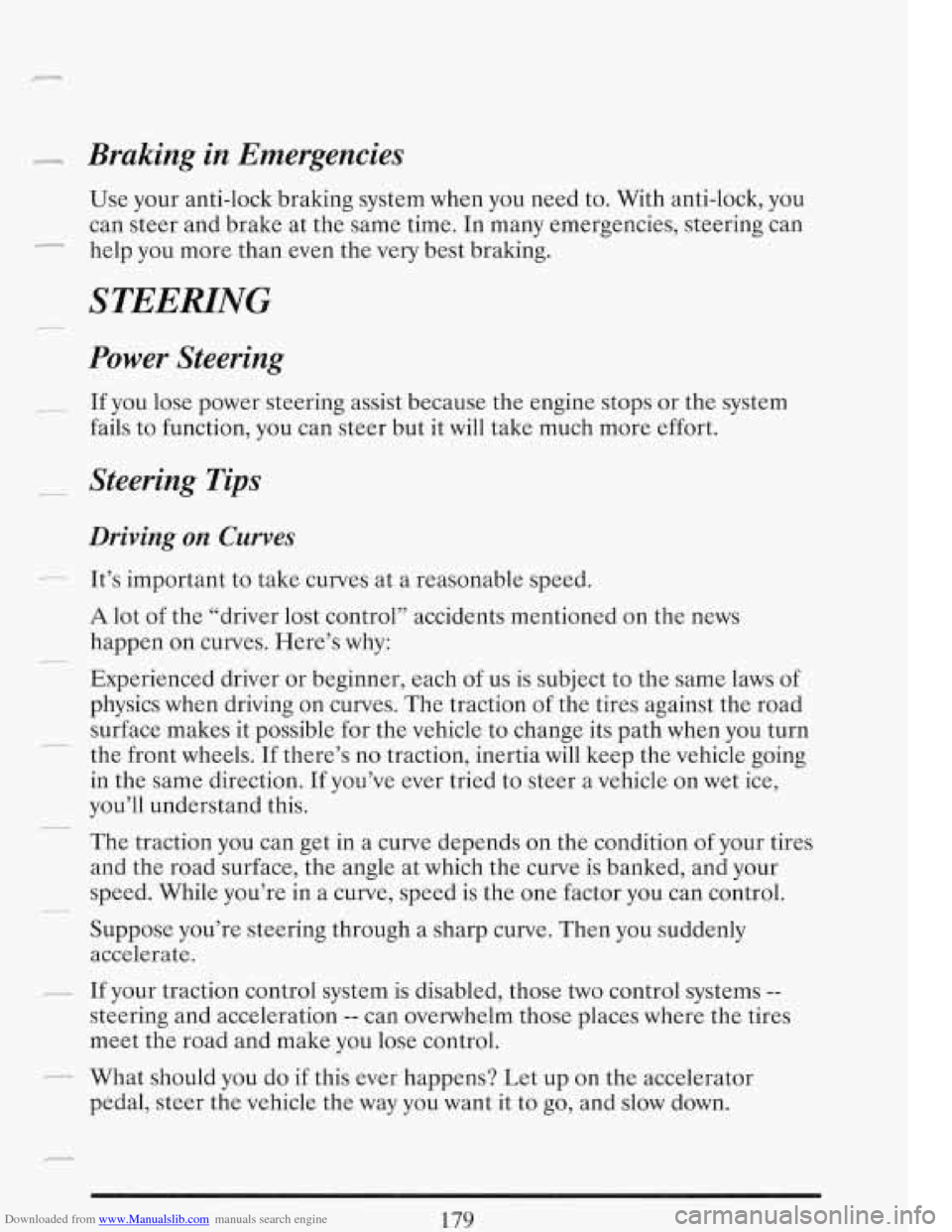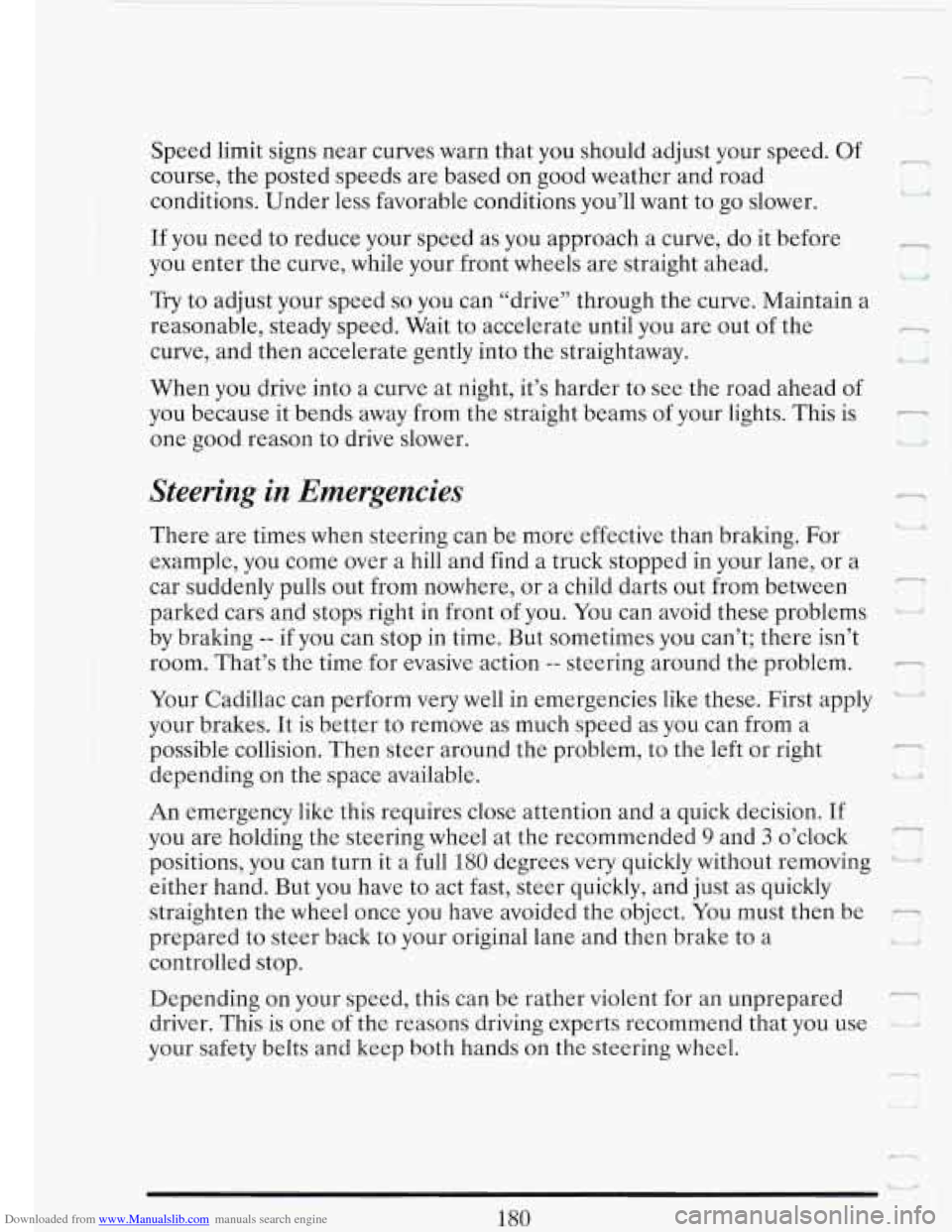Page 94 of 386
Downloaded from www.Manualslib.com manuals search engine If your key seems stuck in “Lock” and you can’t turn it, be sure
it is all the way in.
If it is, then turn the steering wheel left and
right while you turn the key hard. But turn the key only with
XI
your hand. Using a tool to force it could break the key or the
ignitior, -w;tch.
If none of this works, then your vehicle needs 7
service,
STARTING YOUR ENGINE
To start your V8 engine:
1. Don’t push the accelerator pedal before starting your engine. In some 1:
other vehicles you might need to do this, but because of your vehicle’s
computer systems, you don’t.
e_
2. Turn your ignition key to “Start.” When the engine starts, let go of the 9
key. The idle speed will go down as your engine gets warm.
-
3. If it doesn’t start within 3 seconds, push the accelerator pedal about
-
one-third of the way down, while you hold the ignition key in “Start.”
When the engine starts, let
go of the key and let up on the accelerator
8,
80
Page 103 of 386
Downloaded from www.Manualslib.com manuals search engine If vou are on a hill: See “Parking on Hills” in the Index. That section
shows how to turn your front wheels.
If you are towing a trailer and are parking on any hill: See “Towing a
Trailer”
in the Index. That section shows what to do first to keep the
trailer from moving.
SHIFTING INTO “P” (PARK)
I A CAUTION:
It can be dangerous to get out of your vehicle if the shift lever is
not fully in
“P” (Park) with the parking brake firmly set. Your
vehicle can roll.
If you have left the engine running, the vehicle can move
suddenly. You or others could be injured. To be sure your vehicle
won’t move, when you’re on fairly level ground, use the steps
that follow.
If you are parking on a hill, or if you’re pulling a
trailer, also see “Parking On Hills” or “Towing a Trailer” in the
~ Index.
Steering Column Shift Lever
1. Hold the brake pedal down with your right foot.
89
Page 109 of 386
Downloaded from www.Manualslib.com manuals search engine _u_ TILT WHEEL
A tilt steering wheel allows you to adjust the height of the steering wheel
before you drive.
You can also raise it to the highest level to give your legs more room
when you exit and enter the vehicle.
g_
To tilt the wheel, hold the steering wheel and pull the lever. Move the
steering wheel to a comfortable level, then release the lever to lock the
wheel in place.
7
- POWER STEERING
Your Cadillac is equipped with Electronic Variable Assist power steering
system. Steering is easier at a lower speed and
when parallel parking. At
I_ higher speeds, steering efforts are increased to improve vehicle stability.
If your engine stops (or the power assist is reduced), you can still steer.
But it will take more effort.
95
Page 111 of 386
Downloaded from www.Manualslib.com manuals search engine ~ Rear Window Lock Out
HORN
With
this feature you
can cut electrical
power to the rear
power windows
by
pressing the right end
of the lock out switch.
This feature is useful
when you’re transporting small
children and you don’t
want them using the
power windows.
To sound the horn, just press the steering wheel pad.
THE TURN SIGNAEIMULTIFUNCTION
LEVER
97
,
i
Page 112 of 386
Downloaded from www.Manualslib.com manuals search engine The lever on the left side of the steering column includes your:
0 Turn Signal and Lane Change Indicator
0 Headlight High-Low Beam & Passing Signal
0 Windshield Wipers
0 Windshield Washer
0 Cruise Control
Turn Signal and Lane Change Indicator
The turn signal has
two upward (for Right)
and
two downward
(for Left) positions.
These positions allow
you to signal a turn or
a lane change.
To signal a turn, move the lever all the way up or down. When the turn is
finished, the lever will return automatically.
98
n
*-' I
n .
*
-
dl
n
-
e-
Page 184 of 386

Downloaded from www.Manualslib.com manuals search engine “I’ll be careful’’ isn’t the right answer. What if there’s an emergency, a
need to take sudden action, as when a child darts into the street?
A
person with a higher BAC might not be able to react quickly enough to
avoid the collision.
There’s something else about drinking and driving that many people
don’t know. Medical research shows that alcohol in a person’s system can
make crash injuries worse. That’s especially true for brain, spinal cord
and heart injuries. That means that
if anyone who has been drinking --
driver or passenger -- is in a crash, the chance of being killed or
permanently disabled is higher than
if that person had not been drinking.
And we’ve already seen that the chance of a crash itself is higher for
drinking drivers.
A CAUTION:
Drinking and then driving is very dangerous. Your reflexes,
perceptions, and judgment will be affected by even a small
amount of alcohol. You could have a serious
-- or even fatal --
accident if you drive after drinking. Please don’t drink and drive
or ride with
a driver who has been drinking. Ride home in a cab;
or if you’re with a group, designate a driver who will not drink. I
CONTROL OF A VEHICLE
You have three systems that make your vehicle go where you want it to
go. They are the brakes, the steering and the accelerator.
All three
systems have to do their work at the places where the tires meet the road.
11
d
a ,’ d
170
Page 193 of 386

Downloaded from www.Manualslib.com manuals search engine Braking in Emergencies
Use your anti-lock braking system when you need to. With anti-lock, you
can steer and brake at the same time. In many emergencies, steering can
help you more than even the very best braking.
STEERING
Power Steering
If you lose power steering assist because the engine stops or the system
fails to function, you can steer but it will take much more effort.
Steering Tips
Driving on Curves
It’s important to take curves at a reasonable speed.
A lot of the “driver lost control” accidents mentioned on the news
happen on curves. Here’s why:
Experienced driver
or beginner, each of us is subject to the same laws of
physics when driving on curves. The traction
of the tires against the road
surface makes it possible for the vehicle to change its path when you turn
the front wheels. If there’s no traction, inertia
will keep the vehicle going
in the same direction. If you’ve ever tried to steer
a vehicle on wet ice,
you’ll understand this.
The traction you can get in a curve depends on the condition
of your tires
and the road surface, the angle at which the curve is banked, and your
speed. While you’re in a curve, speed is the
one factor you can control.
Suppose you’re steering through a sharp curve. Then you suddenly
accelerate.
If your traction control system
is disabled, those two control systems --
steering and acceleration -- can overwhelm those places where the tires
meet the road and make you lose control.
What should you do if this ever happens? Let up on the accelerator
pedal, steer the vehicle the way you want it to go, and slow down.
179
Page 194 of 386

Downloaded from www.Manualslib.com manuals search engine c 1
Speed limit signs near curves warn that you should adjust your speed. Of
course, the posted speeds are based on good weather and road
conditions. Under less favorable conditions you’ll want to go slower.
If you need to reduce your speed as you approach a curve, do it before
you enter the curve, while your front wheels are straight ahead.
Try to adjust your speed so you can “drive” through the curve. Maintain a
reasonable, steady speed. Wait to accelerate until you are out of the
curve, and then accelerate gently into the straightaway.
When you drive into a curve at night, it’s harder to see the road ahead of
you because it bends away from the straight beams of your lights. This is
one good reason to drive slower.
n
cz;
n
Steering in Emergencies
There are times when steering can be more effective than braking. For
example, you come over a hill and find a truck stopped in your lane, or a
car suddenly pulls out from nowhere, or a child darts out from between
parked cars and stops right in front
of you. You can avoid these problems
by braking
-- if you can stop in time. But sometimes you can’t; there isn’t
room. That’s the time for evasive action
-- steering around the problem. -
-
Your Cadillac can perform very well in emergencies like these. First apply
your brakes. It is better to remove as much speed as you can from a
possible collision. Then steer around the problem, to the left or right
depending on the space available. I,
An emergency like this requires close attention and a quick decision. If
you are holding the steering wheel at the recommended
9 and 3 o’clock
positions, you can turn it a full
180 degrees very quickly without removing ‘ i’
either hand. But you have to act fast, steer quickly, and just as quickly
straighten the wheel once you have avoided the object. You must then be
-
7
prepared to steer back to your original lane and then brake to a
controlled stop.
Depending on your speed, this can be rather violent for an unprepared
driver. This is one of the reasons driving experts recommend that you use
your safety belts and keep both hands
on the steering wheel.
-1
r P
180